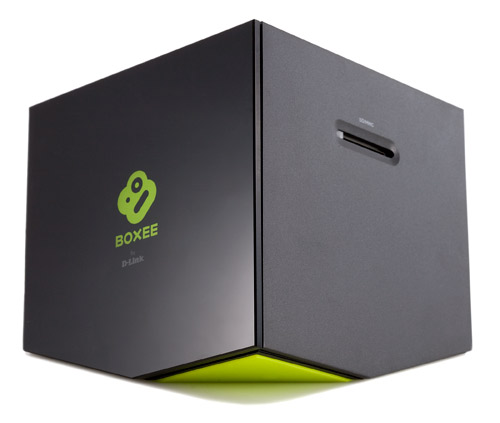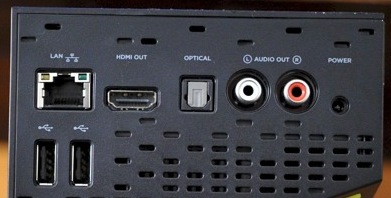Archive:Boxee Box
The company Boxee might be long dead, but the community has finally hacked the Boxee Box from D-Link to run a port of XBMC that is currently being improved on by independent developers, breathing new life into the still-fairly decent hardware.
This wiki page is a collection of links, information, tips, and guides related to running XBMC on that Boxee Box hardware from D-Link. Please note that Team-XBMC does not "officially" support XBMC on the Boxee Box and does therefor not directly provide any binaries for it. Not yet, at least.
Overview
Boxee Box by D-Link is a Linux based media player powered by Intel Atom CE4100 media processor. It first became available in 2010, and the Boxee Box remote that comes with it is a dual-sided RF remote / QWERTY keyboard that probably inspired the design many of the air mouse remotes that are available today.
The hardware box features many of the ports and connectors that are available on most Android media players today, namely an HDMI-port, an optical SP/DIF for digital audio out, a stereo RCA analog audio out, RJ-45 Ethernet port, and 802.11n Wi-Fi, two USB-ports, and an SD card slot.
Most people however was disappointed with the firmware of the Boxee Box at launch time, and even if subsequent firmware updates did greatly improved the user experience, many considered the effort of porting XBMC to the device early on, but due to NDK agreements with application makers like Netflix the Boxee Box shipped as a closed product and it is not until recently it has been made easy to hack.
Builds
Unofficial Builds
XBMC 13 builds for Boxee Box: http://www.devil-strike.com/xbmc_boxee/index.php or http://boxeed.in/forums/viewtopic.php?f=13&t=148
Installing XBMC
Gaining root access and installing XBMC on the Boxee box is today a relatively simple process and should not take longer than 15-30 minutes. All that you will need is a USB memory stick (external USB-harddrive will work as well) or an SD card. High speed USB memory stick is recommended over SD card as they help improve the performance of XBMC, (so if you insist on using a SD card then please consider to using a Class 10 model or faster).
Install Boxee+Hacks to gain root access
The first thing you will have to do is to gain root access o the Boxee Box, and to do that follow these steps to install "Boxee+Hacks" which does exactly that.
1. Download install.zip (Boxee+Hacks) from http://boxeed.in/ (use Boxee Hacks version 1.5.3+ or later) installion package and unzipping it somewhere on your harddrive 2. Format a USB flash drive or SD card to FAT32 using the label BOXEE (noting that "BOXEE" is case sensitive so be sure to only use capital letters) 3. Copy the contents of the 'install' folder with the files from the zip files that you downloaded earlier to the USB memory stick or SD card 4. Plug it into the device, and boot Boxee Box 5. In the menu of Boxee Box original software go into ‘Settings’->’Network’->’Servers’ to enable ‘Windows File Sharing’ 6. Add ‘;sh /media/BOXEE/install.sh‘ to your ‘Host Name’. Make sure it looks like ‘boxeebox;sh /media/BOXEE/install.sh‘ after you are done. 7. Reboot the device to start the install process. 8. Once it is complete you will have a device with root access.
Installing XBMC on Boxee Box
There are two ways to get XBMC for Boxee Box. The first is compiling a build yourself XBMC from source using code by following the instructions available on https://github.com/quarnster/boxeebox-xbmc, or much simpler, download the latest pre-compiled version from http://www.devil-strike.com/xbmc_boxee/index.php
Once you finished building it or downloading the zip file, extract the files to the root of a storage device (USB flash drive or SD card) making sure xbmc.bin is in the root folder, insert the storage device in Boxee Box, power the device, and it should automatically boot into XBMC.
If you want to go back to Boxee original software just remove USB-memory/USB-disk/SD-card and reboot the Boxee Box. Once you remove the storage device, it will just load the "Boxee+Hacks" that you have installed previously, booting the original Boxee Box software.
FAQ
Known issues
- It recommended to do a clean install of XBMC (remove all files) if you have a previous version of XBMC installed.
- For now is recommended to always remove all files from USB-memory/USB-disk/SD-card when updating to a later version of XBMC.
- You might need to reboot the Boxee Box to make changes in XBMC settings and configurations take effect.
- TrueHD and DTS-HD are not working yet (while DD/AC3 and DTS inside TrueHD and DTS-HD respectively works fine).
- Some users have some sort of audio-drops when enable HDMI or SP/DIF pass-through.
- When XBMC starts you mght get following error: "Failed to start common cache", this is a knows issue, try rebooting.
Random notes
Feel free to place various notes, tips, and links here. As this section of the wiki gets more organized, those notes will be properly sorted. Consider this like a dumping ground for when you're not sure where to put something.
- If you like the look and feel of the original Boxee software but you want all the bells and whistles of XBMC then you might also want to tryout a Boxee style skin for XBMC called Boxee Inspirat, checkout it out at http://forum.xbmc.org/showthread.php?tid=124222
- Myles McNamara have written good instructions on how to install XBMC on Boxee Box D-Link which also include some back-story http://smyl.es/how-to-obtain-root-install-and-run-xbmc-on-d-link-boxee-box/
- The original Boxee+Hacks repository and website/forums was previously https://github.com/boxeehacks/boxeehack and http://boxeeplus.com
Development
If you want to help develop XBMC for Boxee Box then you can get the source code here on GitHub
Instructions for compiling XBMC for Boxee Box can be found here
Code repository of Boxee+Hacks for rooting access hack and other tools can be found here
- https://github.com/cigamit/boxeehack (further discussion can be found at http://boxeed.in )
See also
Other links
- http://forum.xbmc.org/showthread.php?tid=192310 XBMC.org forum thread about XBMC for Boxee Box.
- http://boxeed.in

